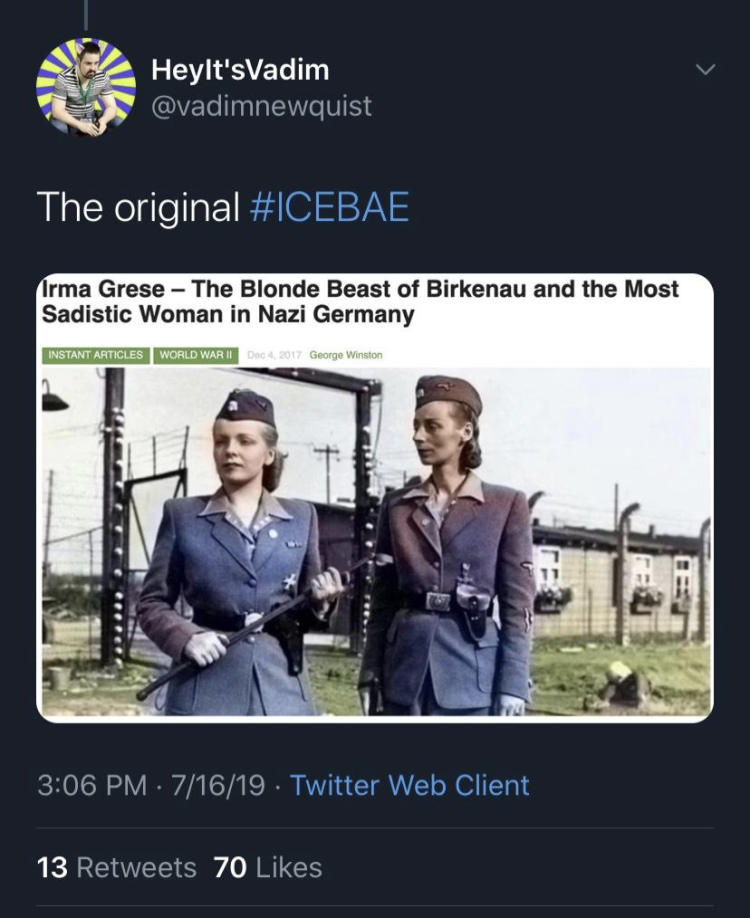Deciphering “ICE Bae” through the Lens of Twitter Politics
How do the American left and right interact on Twitter, particularly in response to viral sensations based in politics?
By: Jewel Ornelas
Course: Language and Digital Media (Ling 3800)
Advisor: Prof. Kira Hall
LURA 2020
As both an avid user of social media and a budding linguistic anthropologist, I tend to notice innumerable fascinating trends and interactions. One particular trend, which I chose as the focus of my research paper for an independent study with Prof. Kira Hall, occurred on Twitter in the summer of 2019. It involved a woman named Kiara Cervantes, or as she is better known from her viral selfie, “ICE Bae.”
The story of ICE Bae’s viral rise has countless layers of meanings and implications, the majority stemming from the fact that Cervantes is obviously of Latinx origin yet is also employed as an officer at an ICE camp in Texas. The viral Twitter incident came from a selfie that Kiara Cervantes posted while she was dressed in her ICE uniform. As her selfie began to trend across the internet, a wide variety of opinions were expressed in response, some vilifying Cervantes and others praising her.
I argue that this event exemplifies how Twitter has become noticeably polarized between U.S. left-wing and right-wing politics under Trump’s presidency, especially with respect to the heated topic of immigration. Such bifurcation has drawn boundaries between “illegal” and “legal” U.S. citizens, increasing tensions within the Latinx and Hispanic communities. These tensions become even more evident when viral trends that are centered on hot button issues arise, as seen in social media conversations surrounding ICE Bae (Kiara Cervantes).
One of the most popularly discussed and dissected features of Trump’s rather unique presidency is his apparent love and frequent use of Twitter. The fact that the U.S. President is such an active user of social media while serving his term is surprising, but the more interesting point lies in how Trump utilizes this platform to express his opinions. Trump’s extreme involvement on Twitter has significantly contributed to the political polarization on Twitter, increasing conflicts between online users of opposing political beliefs.

Based on the numerous tweets I examined in relation to the Twitter viral phenomenon of ICE Bae, I found several differences between discourses used by left and right political users on social media. Generally, at least for emotionally charged issues like immigration, it seems that the U.S. left Twitter engages in a kind of discourse that is more radicalized and passionate. This is often communicated through extreme comparisons, such as comparing ICE Bae Kiara Cervantes to “sadistic women” in Nazi Germany (see tweet pictured left). Such posts often use marked profanity, frequently in direct reply to right Twitter users.

In contrast, the right tends to play a more aloof role by focusing solely on positive aspects of the news story in question and ignoring the controversy (unless overtly slandering the opposing left side). For instance, a viral tweet about Kiara Cervantes from the verified Fox and Friends Twitter account featured a video focused on ICE Bae’s positive qualities. The video does not acknowledge the critique of ICE Bae’s position as an immigration officer until the last 30 seconds. Such tweets often celebrate the ways that people on the right are able to “think for themselves,” as opposed to people on the left. The tweet pictured to the right, for instance, entirely ignores the main controversy behind the incident and instead praises Cervantes in a way that makes it seem like it’s all simply a matter of differing opinions, with no deeper implications: “We can think for ourselves and we can think differently.”
However, in addition to this comparatively indirect tactic, my research also found that right-wing Twitter users often employ “troll” responses as a tactical tool to gaslight the left. This argumentative tactic was more often used by Twitter users who overtly stated or implied affiliation with the U.S. political right wing. These users often argued their opinions using unsupported logic until their opposing Twitter user simply stopped responding. The cessation of response by left Twitter users in arguments causes right Twitter users to feel satisfaction, believing that the lack of response indicates “a win.”
Although this study is by no means a comprehensive analysis of the countless tweets highlighting the growing political divide between right and left Twitter users, the regularities across my data point to certain linguistic methods that vary according to the user’s political affiliation and invite further research.


